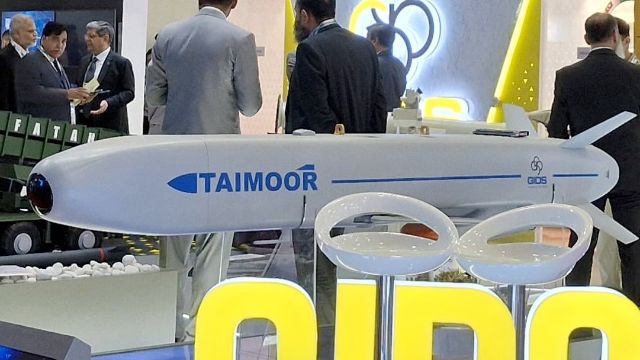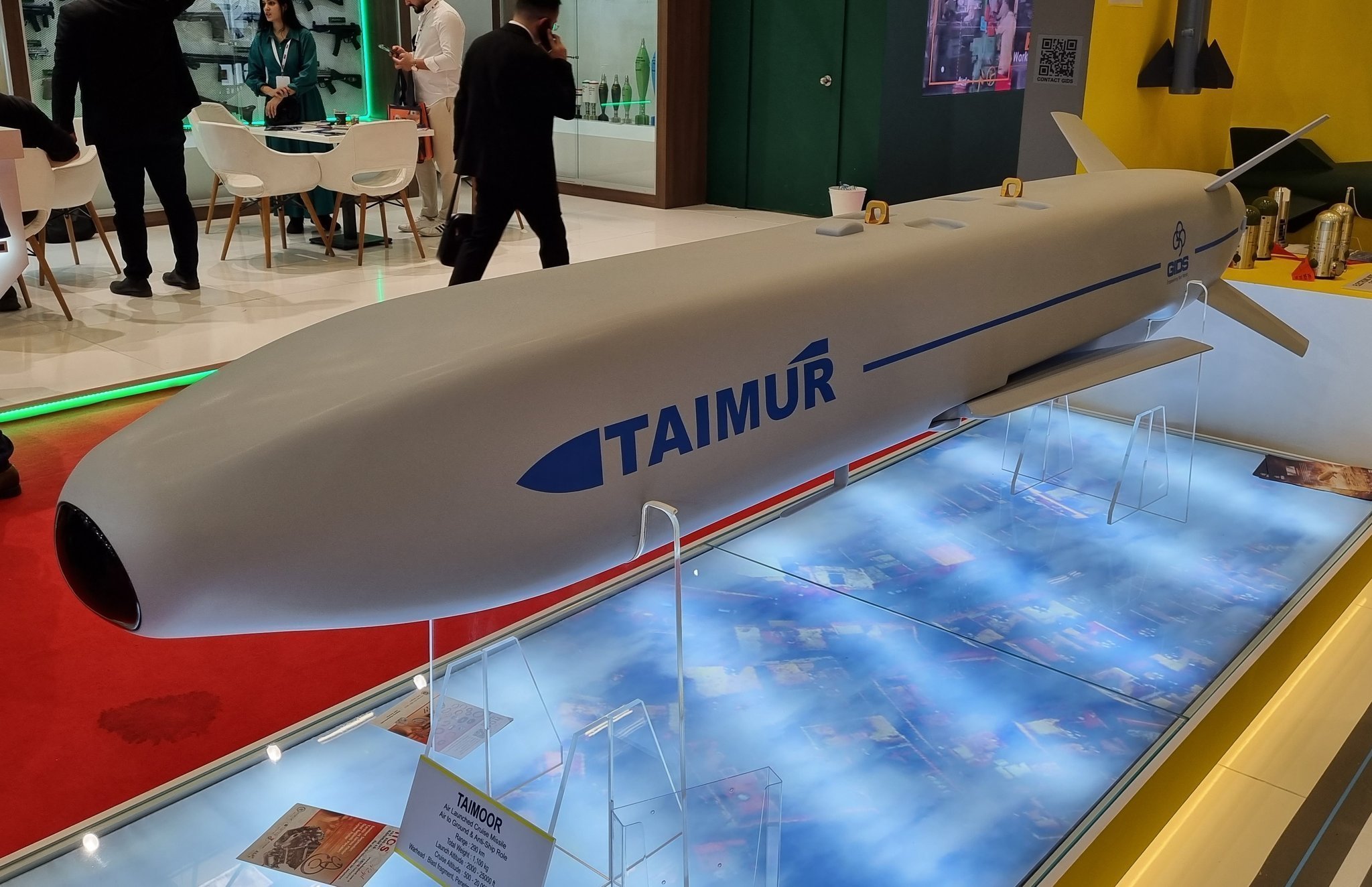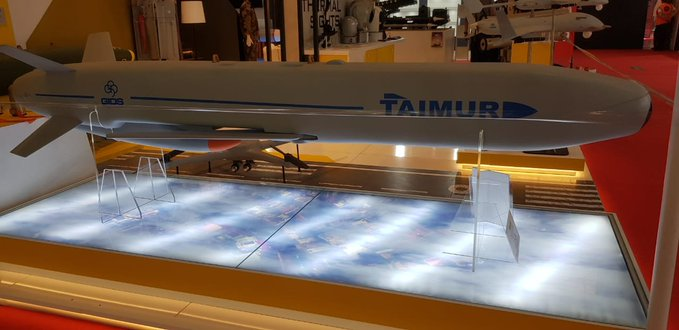Pakistan’s “Taimur” ALCM Challenges Western Supremacy in Cruise Missile Warfare
The missile was developed by Global Industrial & Defence Solutions (GIDS), Pakistan’s state-owned defence conglomerate, and is engineered for penetrating modern air defences to strike strategic surface targets from stand-off ranges.

(DEFENCE SECURITY ASIA) — First revealed in 2022, Pakistan’s “Taimur” (also spelled “Taimoor”) Air-Launched Cruise Missile (ALCM) signals a bold new stride in Islamabad’s pursuit of long-range, precision-guided, air-delivered strike capabilities.
The missile was developed by Global Industrial & Defence Solutions (GIDS), Pakistan’s state-owned defence conglomerate, and is engineered for penetrating modern air defences to strike strategic surface targets from stand-off ranges.
Designed for export, the “Taimur” is a derivative of the RAAD-II ALCM, a platform widely believed to be nuclear-capable, and with a reported strike envelope of up to 600 kilometres.
Its development signals Pakistan’s entry into a competitive global marketplace dominated by sophisticated Western systems such as the Anglo-French Storm Shadow/SCALP by MBDA and Turkey’s SOM missile produced by ROKETSAN.
With a maximum declared range of 290 kilometres in its conventional export configuration, the “Taimur” provides Pakistani fighter aircraft with the ability to neutralize high-value naval and ground-based targets while remaining outside the engagement envelope of most surface-to-air missile systems.
The missile is widely believed to be compatible with Pakistan’s JF-17 “Thunder” multirole fighter, an aircraft co-developed with China that is fast becoming the backbone of the Pakistan Air Force (PAF) following the gradual retirement of legacy Mirage III/IV strike platforms.
Equipped with an Imaging Infrared (IIR) seeker, the “Taimur” is optimized for high-precision targeting and is capable of engaging moving targets under heavy electronic warfare environments and GPS jamming.

Its low-altitude “terrain-hugging” and “sea-skimming” flight profiles further enhance its survivability by exploiting radar blind zones and coastal clutter to remain undetected until the final moments before impact.
Subsonic yet stealthy, the “Taimur” is designed to maintain flight stability and radar evasion throughout its trajectory, using intelligent guidance systems to deliver pinpoint accuracy.
Key Specifications of the “Taimur” ALCM:
-
Range: 290 km
-
Warhead Type: Blast-fragmentation
-
Guidance: Inertial Navigation System (INS) and Global Navigation Satellite System (GNSS)
-
Length: 4.38 meters
-
Weight: 1,100 kg
-
Wingspan: 3.2 meters
The missile’s navigational brain—a fusion of INS and GNSS—is designed to offer precision strike capability in GPS-contested environments, enhancing mission flexibility and ensuring penetration of sophisticated, multi-layered air defence networks.
Designed with a modular architecture, the “Taimur” marks the third evolution in the RAAD ALCM series, allowing for scalable upgrades in propulsion, guidance, and payloads to maintain operational relevance amid evolving threat spectrums.
Its predecessor, the RAAD ALCM, was equipped with a turbojet engine and could strike targets up to 600 kilometres away, giving Pakistan a credible air-launched standoff capability against strategic maritime and terrestrial assets.

The RAAD-II variant represents a generational leap forward in range, stealth, and precision, significantly enhancing Pakistan’s ability to project force from the air in a standoff role without risking valuable aircraft within enemy air defence umbrellas.
Open-source intelligence indicates that Pakistan has successfully integrated the RAAD series—including the “Taimur”—onto its JF-17 Thunder platforms, a significant milestone that consolidates its indigenous strike ecosystem.
These JF-17s, seen increasingly as replacements for the nuclear-capable Mirage fleet, offer Pakistan a more sustainable and flexible delivery system for both conventional and strategic payloads.
A 2023 assessment by the Federation of American Scientists (FAS) concluded that Pakistan has “very likely integrated the nuclear-capable RAAD ALCM onto the JF-17 fighter platform, which it developed in collaboration with China.”
This conclusion was derived from high-resolution imagery and video footage of the 2023 Pakistan Day Parade released by Inter-Services Public Relations (ISPR), where JF-17s were seen carrying air-launched cruise missiles matching the dimensions of RAAD-class systems.
Using photo analysis techniques, FAS determined that the air-launched variant carried by the aircraft was identical in length and shape to ground-launched cruise missiles displayed on transporter-erector-launchers during the same parade.
This finding supports the assessment that Pakistan has successfully miniaturized and adapted its air-launched strategic cruise missile capability to platforms beyond the ageing Mirage series.

The integration of the RAAD and Taimur missiles with the JF-17 platform marks a significant shift in Pakistan’s nuclear doctrine, pointing toward a more agile, survivable, and decentralized second-strike capability.
This evolution reflects broader regional dynamics, especially in the wake of India’s growing emphasis on advanced air defence systems like the S-400 Triumf, as well as its own air-launched BrahMos missile developments.
With Taimur, Pakistan signals its intent not only to maintain deterrence credibility but to reinforce it through technological sophistication and platform diversification, reducing reliance on vulnerable legacy systems.
In a region marked by strategic instability, tit-for-tat modernisation, and shrinking warning times, the Taimur ALCM introduces a new variable into South Asia’s already complex deterrence calculus.
Stealthy, versatile, and precision-engineered for the next generation of asymmetric air warfare, the “Taimur” could soon form the cutting edge of Pakistan’s evolving airpower doctrine.
— DEFENCE SECURITY ASIA


These all are chinese missiles renamed. It’s effectiveness will be inferior to other missiles.
Best of luck in sha Allah.